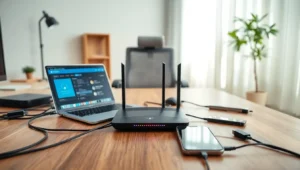In a world where connecting to the internet feels as essential as breathing, IPv6 configuration is the superhero we didn’t know we needed. With the internet running out of IPv4 addresses faster than a cat video goes viral, it’s time to embrace the future. IPv6 swoops in with an almost unlimited number of addresses, ensuring that every toaster, fridge, and even your neighbor’s pet goldfish can join the digital party.
Table of Contents
ToggleUnderstanding IPv6 Configuration
IPv6 configuration plays a crucial role in expanding internet connectivity. The transition from IPv4 addresses to IPv6 addresses ensures a broader range of devices can connect seamlessly.
Importance of IPv6
The importance of IPv6 stems from its ability to provide over 340 undecillion unique addresses. IPv6 addresses support the growing number of internet-enabled devices, ensuring each can connect efficiently. With the advent of smart technology, such as IoT devices, having a vast address space is vital. Additionally, IPv6 prioritizes security and offers improved routing capabilities, which enhances overall internet performance. Adopting IPv6 also fosters faster innovation in technology, creating opportunities for future growth.
Transition from IPv4 to IPv6
The transition from IPv4 to IPv6 is necessary due to the exhaustion of IPv4 addresses. IPv4 supports approximately 4.3 billion addresses, which are insufficient for today’s population and devices. Migrating to IPv6 allows organizations to scale their networks without facing address limitations. Network managers can adopt dual-stack configurations during the transition, enabling both IPv4 and IPv6 functionality simultaneously. Implementing IPv6 enhances connectivity and simplifies network management by reducing the complexity associated with NAT (Network Address Translation).
Key Components of IPv6 Configuration

Key components of IPv6 configuration include addressing types and prefix lengths. Understanding these elements aids in the effective deployment and management of IPv6 networks.
Addressing Types
IPv6 offers several addressing types which serve different purposes. Unicast addresses target a single interface, while multicast addresses allow data transmission to multiple interfaces simultaneously. Anycast addresses facilitate communication with the nearest interface from a group, efficiently directing packets to the optimal destination. These addressing types are essential for optimizing traffic flow and resource utilization in diverse network environments. Effective management of these addressing types supports both large-scale implementations and efficient local networks.
Prefix Length
Prefix length defines the size of the network portion of the address. Represented in CIDR notation by a slash (/) followed by a number, it indicates the number of bits allocated to the subnet. For instance, a prefix length of /64 is standard for most networks, balancing simplicity and efficiency. Smaller prefix lengths, such as /48 or /32, accommodate larger networks. Consider using a proper prefix length to ensure optimal routing and effective network segmentation. Proper configuration contributes to network performance and facilitates future scalability.
Steps for Configuring IPv6
Configuring IPv6 involves various methods that cater to different network needs. Two common approaches are manual configuration and utilizing DHCPv6.
Manual Configuration
Manually configuring IPv6 requires addressing and prefix length details. Administrators input the IPv6 address directly into each device’s network settings. This method provides complete control over addressing but can be tedious for large networks. Emphasis on correct prefix lengths ensures optimal routing and efficient use of addresses. Assigning a unique unicast address to each interface enhances traffic management. Adjustments may need to be made for devices, adding complexity during updates. Regular audits of the configuration help maintain consistency and reliability.
Using DHCPv6
DHCPv6 streamlines the IPv6 address assignment process. This method automates the configuration of devices, reducing manual input time and error risk. Devices can request an address automatically from the DHCPv6 server, simplifying management. The server assigns addresses based on defined scopes and settings, enhancing network efficiency. Additionally, using DHCPv6 supports dynamic updates, allowing seamless address assignments as devices connect. Leveraging this method fosters easier network expansion and security, accommodating growth in the number of connected devices.
Tools for IPv6 Configuration
Various tools assist in configuring IPv6, streamlining the process and enhancing network management.
Command-Line Utilities
Command-line utilities play a significant role in network administration. Common commands include ping, traceroute, and ipconfig, which help diagnose connectivity issues. Network tools such as ifconfig and ip enable administrators to view and modify configurations quickly. Understanding how to utilize these commands enhances troubleshooting capabilities and provides immediate feedback on network conditions. Additionally, ping6 tests reachability of IPv6 addresses, while netstat shows active connections. Mastering these utilities ensures efficient management of IPv6 networks.
Graphical Interfaces
Graphical interfaces simplify the complexities of IPv6 configuration. Many operating systems offer user-friendly applications for managing network settings visually. Tools like Network Manager on Linux and Windows’ Network and Sharing Center allow easy adjustments of IPv6 parameters. Administrators benefit from intuitive navigation, enabling quick changes such as enabling DHCPv6 or manually setting addresses. These interfaces help visualize network layouts, enhancing understanding of addressing schemes. Supporting both novice and experienced users, graphical tools promote effective configuration and monitoring while minimizing potential errors.
Common Challenges in IPv6 Configuration
Configuring IPv6 poses several challenges, including compatibility issues and troubleshooting complexities. These obstacles can hinder successful deployment and require careful consideration.
Compatibility Issues
Compatibility remains a significant challenge during IPv6 configuration. Many legacy systems still rely on IPv4, leading to difficulties when integrating newer IPv6 networks. Devices that lack support for IPv6 may experience connectivity problems in dual-stack environments, limiting functionality. Software applications also tend to vary in their ability to work seamlessly with IPv6. For example, outdated security software may not recognize or properly handle IPv6 traffic. Furthermore, some network hardware may require firmware updates to support IPv6 features. Organizations often encounter conflicts during these transitions, emphasizing the importance of evaluating compatibility before initiating deployment.
Troubleshooting Techniques
Effective troubleshooting techniques play a vital role in resolving issues that arise during IPv6 configuration. Operators must utilize ping and traceroute to diagnose connectivity problems, as these tools can quickly identify routing issues or device unreachability. Checking network settings on devices provides critical insights into configuration errors. Tools like Wireshark allow for packet analysis, revealing the specifics of IPv6 traffic and potential bottlenecks. Utilizing DHCPv6 logs also offers valuable information regarding address assignment failures. Implementing systematic approaches can streamline these troubleshooting efforts, ensuring quicker resolutions and smoother network performance.
Adopting IPv6 configuration is no longer optional; it’s a necessity for future-proofing networks. Organizations must embrace this shift to ensure they can support the increasing number of connected devices while avoiding the pitfalls of IPv4 exhaustion.
With the right tools and techniques, configuring IPv6 can be streamlined, allowing for efficient network management. Understanding addressing types and prefix lengths is crucial for optimal performance.
While challenges may arise during the transition, effective troubleshooting and strategic planning can mitigate these issues. By prioritizing IPv6, businesses position themselves for growth and innovation in an increasingly digital world.





